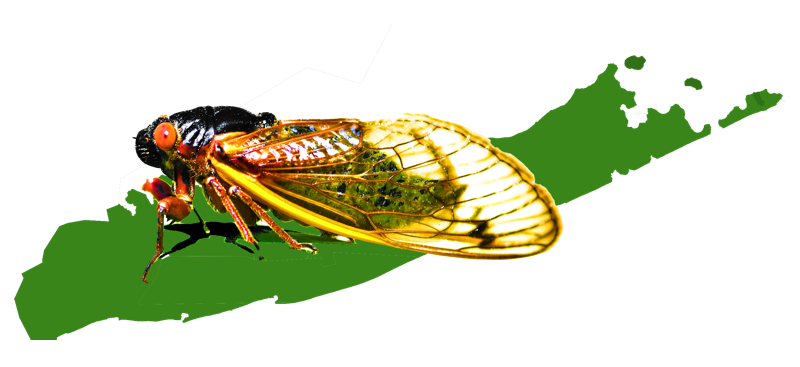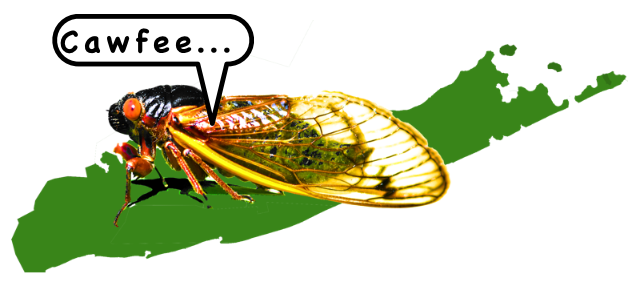
Elias Bonaros found cicadas in 2021 in Bohemia County Park and East Setauket.
Brood X periodical cicadas will emerge this spring (May) in the eastern U.S. — hopefully in Long Island as well. Chris Simon asked me to post this on the site. Brood X cicadas were hard to find in Long Island on 2004 — so we really want to find so, and how Long Islanders can help. Report cicadas with the Cicada Safari app.
Brood X may have breathed its last breath on Long Island! Or maybe not. This year may in fact reveal localities that we missed in 2004. It may capture people’s imagination just like the hunt for the last Ivory-Billed Woodpecker in Arkansas or the last Tasmanian Tiger in Tasmania.
Brood X cicadas were previously found on Long Island and it is unclear whether they are extinct or not! We are hoping to advertise the Cicada Safari app to your readers so they can help us find Brood X.
Attached is the Newsday article from 2004 that describes the previous Brood X emergence. Sites include Shirley, and Connetquot River State Park Preserve in Oakdale (Northeast section), and Ronkonkoma.
This locality info for Long Island is from the appendix of Simon and Lloyd 1982, J. N.Y. Ent. Soc.
It documents the historical decline of Brood X on Long Island as follows…
1902: Davis (1920) quoted the eighteenth report of the N.Y. State entomologist (1902. p. 113) as follows, “The insects were observed… at Wantagh. Nassau Co., also between Massapequa and Amityville, between Sayville and Oakdale, east of Patchogue to Brookhaven and also to the north of Medford and Holtsville, and a small brood [sic] northeast of Riverhead, all in Suffolk Co.” Davis (1907) reported that although a friend had seen hundreds of exuviae of the 17 -year locust in Prospect Park, Brooklyn. he had only obtained three adults and he “attributed their scarcity to the English Sparrow.”
1919: The New York Times of June 17th, 1919 (p. 25:3) talked with farmers in the vicinity of Farmingdale, Bethpage, and Massapequa who reported thousands of cicadas doing damage to fruit trees and other hardwoods. Old residents claimed that 17 years before they were not nearly so numerous. Daviis (1919) recorded” 1 7 -year cicadas singing at Mastic, L.L during the first week of June.” In another publication (Davis 1920) he noted them as occurring on South Country Road just cast of Carman’s River, and in the woods just east of Patchogue; also from Wantagh to Farmingdale and as far north as Central Park on Long Island; finally, north and east of Massapequa railroad station.
1936: The New York Times (June 12, 1936, p. 4:7) reported that the cicadas were found “first in Carmen Ave., Farmingdale … since then the swarms have been reported at Massapequa, and all through Suffolk scrub oak along the Motor Parkway from Medford westward to Farmingdale.” They were also seen along the Sunrise Highway in Massapequa Park.
1970: Newsday (June 5, 1970, p. 12) lists two exact localities Skylark Drive (Holtsville) and Springdale Drive (Ronkonkoma). They explained that “officials of the State Conservation Department and County Agricultural Extension Service said … that they have received hundreds of complaints this month about the insects. Most of the calls have come from an area including Ronkonkoma, Holtsville, Islip, and Sayville. where the influx is concentrated.” The same newspaper (June 23. 1970) reported 17-year cicadas in Bohemia on eighth Street near the South Side Sportsman’s preserve. They must have been abundant because “50 Bohemia residents … signed petitions appealing for help to fight the alarming problem of swarming cicada locusts [sic].”
Other, more recent, records…
1987: Suffolk Co. Long Island. Chris Simon and her student Andrew Martin collected periodical cicadas at Bohemia Equestrian Park in Oakdale and in Shirley.
2004: Suffolk Co. Long Island. Bryn Nelson of Newsday reports that periodical cicadas, “made only cameo appearances this year — first in East Setauket and later in Connetquot River State Park Preserve in Oakdale….Particularly vexing is the sputter at Connetquot, which reported masses of cicadas in its northeastern section both in 1987 and in 1970. Gary Lawton, a regional environmental education coordinator for New York State Parks, reported hearing a few cicadas at the park about three weeks ago….But after a few days, the calling abruptly stopped.” Residents of Shirley near the South Shore of Long Island, who saw them in 1987, did not see an emergence in their yards in 2004.
Some more locations from 1987 compiled by Thomas Kowalsick of the Cooperative Extension of Cornell University (specific addresses redacted):
Loughlin Drive, Shirley, NY
Happy Acres Drive, Shirley, NY
Malba Drive, Shirley, NY
Windus Drive, Shirley, NY
Peconic Street, Ronkonkoma, NY
Springdale Drive, Ronkonkoma, NY
Julia Goldback Avenue, Ronkonkoma, NY
Goldbach Avenue, Bohemia, NY
Connetquot River State Park, Oakdale, NY
Mayflower Lane, Setauket, NY

4 replies on “Brood X Cicadas in Long Island? Let’s find them”
I was born & raised on L.I. – in Freeport (south shore) from 1959 to 1994 when I left & I have clear memories of the loud sounds of these giant insects & seeing them all over the sidewalks. I recall cats loving to bat them around & even eat them. I guess this must have been back in 1970, yet Freeport isn’t listed above…they were there though, for sure! The sound of their “singing” every morning along with the sun & humidity of summer, brings back fond memories.
Hi All, fellow entomologist here on Long Island. I plan to search for Brood X (or early Brood XIV) as much as possible this season and wonder where the best place is to report them, if I am somehow successful. Here? UCONN’s site? Would recordings of the calls be enough verification? Thanks!
Connect with Chris Simon of UConn.
Thanks Dan! John Cooley reminded me that I forgot to mention that we might also see new populations of Brood X which are derived from 4-year early emergences of Brood XIV on Long Island! Brood XIV is widespread in Suffolk Co. (eastern LI). And I thought of a new title for the article: Brood X on Long Island: Swan Song, Dodo Song, or Phoenix!